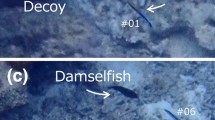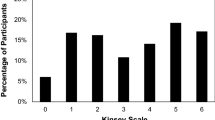Abstract
Animal communication occurring in wide networks can involve signals sent to several receivers. The animals composing the audience may affect how individuals display during an interaction and may change the message that is sent. In this study, we investigated whether the presence of a conspecific affected the intensity of agonistic interaction between male fiddler crabs, Uca maracoani. Pairs of males of the same size were observed when in the presence of a male, a female or no crab as audience. We found that if there is a female audience, males became more aggressive and interacted the most. Also, the female audience leads to an increase in incidence of male foaming, possibly indicating predisposition for mating. If the audience was a male or if there was no audience, there was no significant difference in interaction. These results indicate that the presence of an audience affects the way male fiddler crabs interact and the type of displays they show. Therefore, the context seems to guide the fiddler crab behavior in terms of how they perform in order to send information about themselves to conspecifics.



Similar content being viewed by others
References
Akçay C, Swift RJ, Reed VA, Dickinson JL (2013) Vocal kin recognition in kin neighborhoods of western bluebirds. Behav Ecol 24:898–905
Andersson MB (1994) Sexual selection. Princeton University Press, New Jersey
Aquiloni L, Gherardi F (2010) Crayfish females eavesdrop on fighting males and use smell and sight to recognize the identity of the winner. Anim Behav 79:265–269
Atema J, Cobb JS (1980) Social behavior. In: Cobb JS, Phillips BF (eds) The biology and management of lobsters, vol 1. Academic Press, New York, pp 409–450
Balsby TJS, Dabelsteen T (2003a) Male calling between courtship sequences in whitethroats: a way to counter intrusions from neighbouring rivals. Behav Process 63:149–157
Balsby TJS, Dabelsteen T (2003b) Male singing behaviour and female presence in the territory in whitethroats Sylvia communis. Acta Ethol 5:81–88
Bolton J, Backwell PYR, Jennions MD (2013) Density dependence and fighting in species with indeterminate growth: a test in a fiddler crab. Anim Behav 85:1367–1376
Booksmythe I, Jennions MD, Backwell PRY (2010) Investigating the “dear enemy” phenomenon in the territory defence of the fiddler crab, Uca mjoebergi. Anim Behav 79:419–423
Bradbury JW, Vehrencamp SL (1998) Principles of animal communication
Brown MB, Forsythe AB (1974) Robust tests for equality of variances. J Am Stat Assoc 69:364–367
Christy JH, Salmon M (1984) Ecology and evolution of mating systems of fiddler crabs (genus Uca). Biol Rev 59(4):483–509
Cobo VJ (2002) Breeding of the spider crab Mithraculus forceps (A. Milne Edwards) (Crustacea, Majidae, Mithracinae) in the southeastern Brazilian coast. Rev Bras Zool Curitiba 19:229–234
Crane J (1975) Fiddler crabs of the world, Ocypodidae: genus Uca. 736
deRivera CE, Vehrencamp SL (2001) Male versus female mate searching in fiddler crabs: a comparative analysis. Behav Ecol 12:182–191
Detto T, Backwell PRY, Hemmi JM, Zeil J (2006) Visually mediated species and neighbour recognition in fiddler crabs (Uca mjoebergi and Uca capricornis). Proc R Soc B 273:1661–1666
Detto T, Jennions MD, Backwell PRY (2010) When and why do territorial coalitions occur? Experimental evidence from a fiddler crab. Am Nat 175:E119–E125
Doutrelant C, McGregor PK (2000) Eavesdropping and mate choice in female fighting fish. Behaviour 137:1655–1668
Doutrelant C, Mcgregor PK, Oliveira RF (2001) The effect of an audience on intrasexual communication in male Siamese fighting fish, Betta splendens. Behav Ecol 12:283–286
Dugatkin LA (2001) Bystander effects and the structure of dominance hierarchies. Behav Ecol 12:348–352
Dzieweczynski TL, Gill CE, Perazio CE (2012) Opponent familiarity influences the audience effect in male–male interactions in Siamese fighting fish. Anim Behav 83:1219–1224
Earley RL, Dugatkin LA (2002) Eavesdropping on visual cues in green swordtail (Xiphophorus helleri) fights: a case for networking. Proc Biol Sci 269:943–952
Gavassa S, Goldina A, Silva AC, Stoddard PK (2013) Behavioral ecology, endocrinology and signal reliability of electric communication. J Exp Biol 216:2403–2411
Giurfa M (2013) Cognition with few neurons: high-order learning in insects. T Neurosci 36:285–294
Giurfa M, Menzel R (2013) Cognitive components of insect behavior. In: Menzel R, Benjamin PR (eds) Invertebrate learning and memory. Elsevier, Amsterdam, pp 14–25
Hammer O, Harper DAT, Ryan PD (2001) PAST: Paleontological Statistics Software Package for education and data analysis. Palaeontolia Electronica 4
Herb BM, Biron SA, Kidd MR (2003) Courtship by subordinate male Siamese fighting fish, Betta splendens: their response to eavesdropping and naïve females. Behaviour 140:71–78
Hirose GL, Negreiros-Fransozo ML (2008). Growth and juvenile development of Uca maracoani Latreille 1802–1803 in laboratory conditions (Crustacea, Decapoda, Brachyura, Ocypodidae). Senckenb bio, 161–168
IDEMA (2008) Instituto de Desenvolvimento Sustentável e Meio Ambiente do Rio Grande do Norte. Perfil do seu município: Extremoz 10: 1–23. (IDEMA, Lagoa Nova)
Jaroensutasinee M, Jaroensutasinee K (2003) Male body size influences female choice and male-male competition in the fiddler crab, Uca paradussumieri Bott, 1973 (Decapoda, Brachyura, Ocypodidae). Crustaceana 76:177–186
Jennions MD, Backwell PRY (1996) Residency and size affect fight duration and outcome in the fiddler crab Uca annulipes. Biol J Linn Soc 57:293–306
Jordão JM, Oliveira RF (2001) Major claws make male fiddler crabs more conspicuous to visual predators: a test using human observers. Hydrobiologia 449:241–247
Klaassen M, Ens BJ (1993) Habitat selection and energetics of the fiddler crab (Uca tangeri). Neth J Sea Res 31:495–502
Mansfield C (2009) The effects of density on intraspecific aggression in the fiddler crab, Uca crassipes, on Mo’orea, French Polynesia, UCB Moorea class: biology and geomorphology of tropical islands. http://escholarship.org/uc/item/2jz4s7z8. Accessed 27 Jul 2016
Masunari S (2006) Distribution and abundance of fiddler crabs Uca Leach (Crustacea Decapoda Ocypodidae) in Guaratuba Bay, Parana State, southern Brazil. Rev Bras Zool 23:901–914
Matessi G, Matos RJ, Peake TM, McGregor PK, Dabelsteen T (2010) Effects of social environment and personality on communication in male Siamese fighting fish in an artificial network. Anim Behav 79:43–49
Matos RJ, McGregor PK (2002) The effect of the sex of an audience on male–male displays of Siamese fighting fish (Betta splendens). Behaviour 139:1211–1221
Matos RJ, Peake TM, McGregor PK (2003) Timing of presentation of an audience: aggressive priming and audience effects in male displays of Siamese fighting fish (Betta splendens). Behav Process 63:53–61
Mautz B, Detto T, Wong BBM, Kokko H, Jennions MD, Backwell PRY (2011) Male fiddler crabs defend multiple burrows to attract additional females. Behav Ecol 22:261–267
McGregor PK (2005) Animal communication networks. Cambridge University Press, Cambridge
McGregor PK, Peake TM (2000) Communication networks: social environments for receiving and signalling behaviour. Acta Ethol 2:71–81
Melo GAS (1996) Manual de identificação dos Brachyura (Caranguejos e siris) do litoral Brasileiro. Plêiade FAPESP, São Paulo
Milner RNC, Jennions MD, Backwell PRY (2010) Eavesdropping in crabs: an agency for lady detection. Biol Lett 6:755–757
Milner RNC, Jennions MD, Backwell PRY (2012) Keeping up appearances: male fiddler crabs wave faster in a crowd. Biol Lett 8:176–178
Murai M, Backwell PRY (2006) A conspicuous courtship signal in the fiddler crab Uca perplexa: female choice based on display structure. Behav Ecol Sociobiol 60:736–741
Muramatsu D, Koga T (2016) Fighting with an unreliable weapon: opponent choice and risk avoidance in fiddler crab contests. Behav Ecol Sociobiol. doi:10.1007/s00265-016-2094-2
Nascimento SA (1993) Biologia do caranguejo-uçá Ucides cordatus. Adema
Oksanen J, Blanchet FG, Kindt R, Legendre P, Minchin PR, O’Hara RB, Simpson GL, Solymos P, Stevens MHH, Wagner H (2013). Package ‘vegan’. Community ecology package, version 2(9)
Parker GA (1974) Assessment strategy and the evolution of fighting behaviour. J Theor Biol 47:223–243
Perry CJ, Barrow AB, Cheng K (2013) Invertebrates learning and cognition: relating phenomena to neural substrate. WIREs Cogn Sci. doi:10.1002/wsc.1248
Pope DS (2000) Testing function of fiddler crab claw waving by manipulating social context. Behav Ecol Sociobiol 47:432–437
R Development Core Team (2015) R: A language and environment for statistical computing. R Foundation for Statistical Computing, Vienna, Austria. http://www.R-project.org/
Rosenberg MS (2001) The systematics and taxonomy of fiddler crabs: a phylogeny of the genus Uca. J Crustacean Biol 21:839–869
Rovero F, Hugues RN, Whiteley NM, Chelazzi G (2000) Estimating the energetic cost of fighting in shore crabs by noninvasive monitoring of heartbeat rate. Anim Behav 59:705–713
Santos LC, Alencar CERD, Freire FAM, Luchiari AC (2015) Agonistic interactions in the male fiddler crab Uca leptodactyla Rathbun, 1898 at varying densities. Crustaceana 88:625–640
Semple S, Gerald MS, Suggs DN (2009) Bystanders affect the outcome of mother-infant interactions in rhesus macaques. Proc Biol Sci 276:2257–2262
Shapiro SS, Wilk MB (1965) An analysis of variance test for normality (complete samples). Biometrika 52:591–611
Thorpe WH, Griffin DR (1962) Ultrasonic frequencies in bird song. Ibis (Lond 1859) 104:220–227
Weir LK, Grant JWA, Hutchings JA (2011) The influence of operational sex ratio on the intensity of competition for mates. Am Nat 177:167–176
Wunderlich AC, Pinheiro MAA, Rodrigues AMT (2008) Biologia do caranguejo-uçá, Ucides cordatus (Crustacea: Decapoda: Brachyura), na Baía da Babitonga, Santa Catarina, Brasil. Rev Bras Zool 25:188–198
Zar JH (2010) Biostatistical analysis, 5th edn. Prentice-Hall, Englewood Cliffs, pp 547–944
Zhang S, Srinivasan MV, Zhu H, Wong J (2004) Grouping of visual objects by honeybees. J Exp Biol 207:3289–3298. doi:10.1242/jeb.01155
Acknowledgments
We thank Ms. Vanessa B. Guerra, Jéssica J. Oliveira and Mr. Sávio A.S.N. Moraes very much for assistance with collection. We thank the anonymous reviewer for helpful comments and constructive criticism.
Author information
Authors and Affiliations
Corresponding author
About this article
Cite this article
dos Santos, L.C., de Morais Freire, F.A. & Luchiari, A.C. The effect of audience on intrasexual interaction in the male fiddler crab, Uca maracoani (Latreille 1802–1803, Decapoda, Ocypodidae). J Ethol 35, 93–100 (2017). https://doi.org/10.1007/s10164-016-0495-3
Received:
Accepted:
Published:
Issue Date:
DOI: https://doi.org/10.1007/s10164-016-0495-3




